
Bambusa - Bamboo: planting and growing
Contents
Bambusa in a nutshell
- Bambusas are non-running bamboos
- Most bamboos of the genus Bambusa are giants
- … but there are compact species well-suited to our gardens
- Not very hardy, these bamboos are mainly for regions with mild winters
- … but they can be grown in pots and brought indoors during frosty winters
- Bambusas prefer partial shade and rich, moist soil
The word from our expert
When delving into botany, particularly bamboos, the genus Bambusa inevitably sparks dreams. One can’t help but imagine bamboo forests and traditional constructions in Southeast Asia… Indeed, Bambusas are bamboos native to tropical or subtropical Asia, holding significant cultural importance in these regions. The giant culms, the bamboo stems, are used to craft buildings, scaffolding, fences, and even pipes.
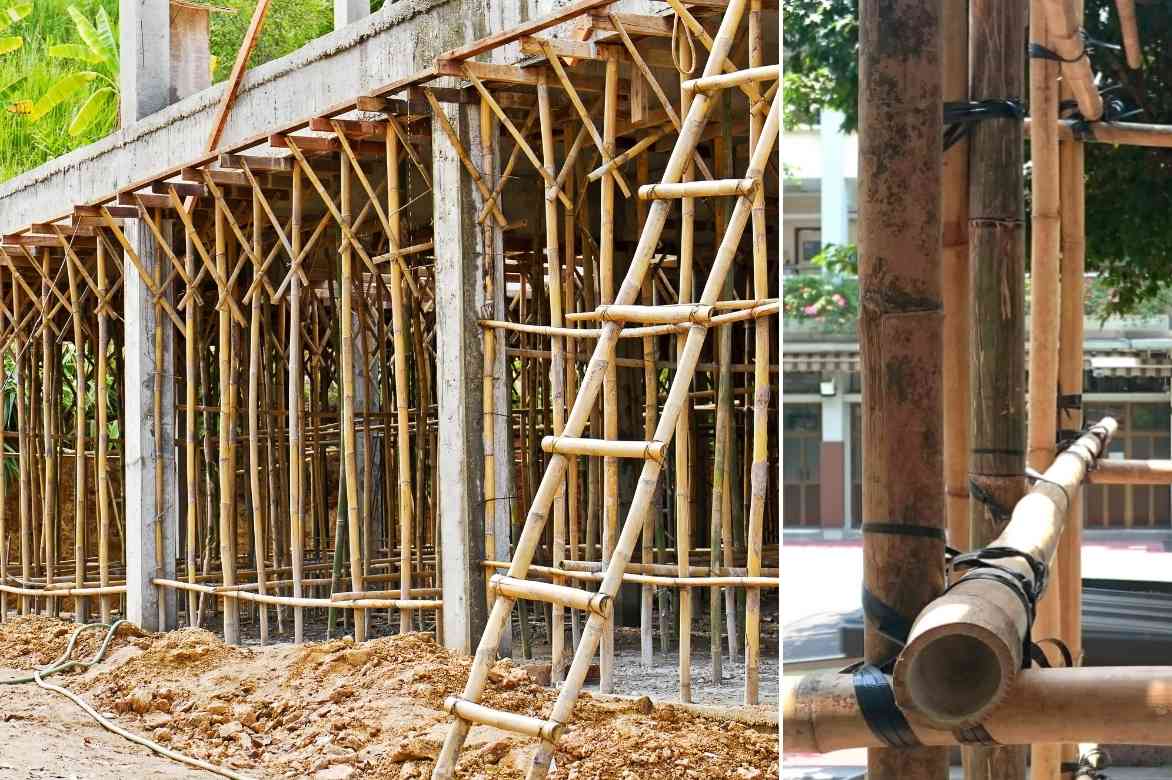
Bambusas are used in Asia to build sturdy scaffolding
Not very hardy, Bambusas thrive in warm and humid climates. So, planting them in the ground north of the Loire is out of the question. However, since these bamboos develop short rootstocks, they are not running. Consequently, not only are they non-invasive in the ground, but they can also be grown in pots, which can be moved to a frost-free location in winter in harsh climates.
Even though most Bambusas are giants, sending their culms soaring several metres high (sometimes over 20 m), there are species and cultivars with much more modest dimensions, such as Bambusa glaucescens Multiplex. Bambusas are relatively easy-going bamboos; they appreciate a warm and humid climate, rich, moist, well-drained soil, and a spot in partial shade or non-scorching sun.
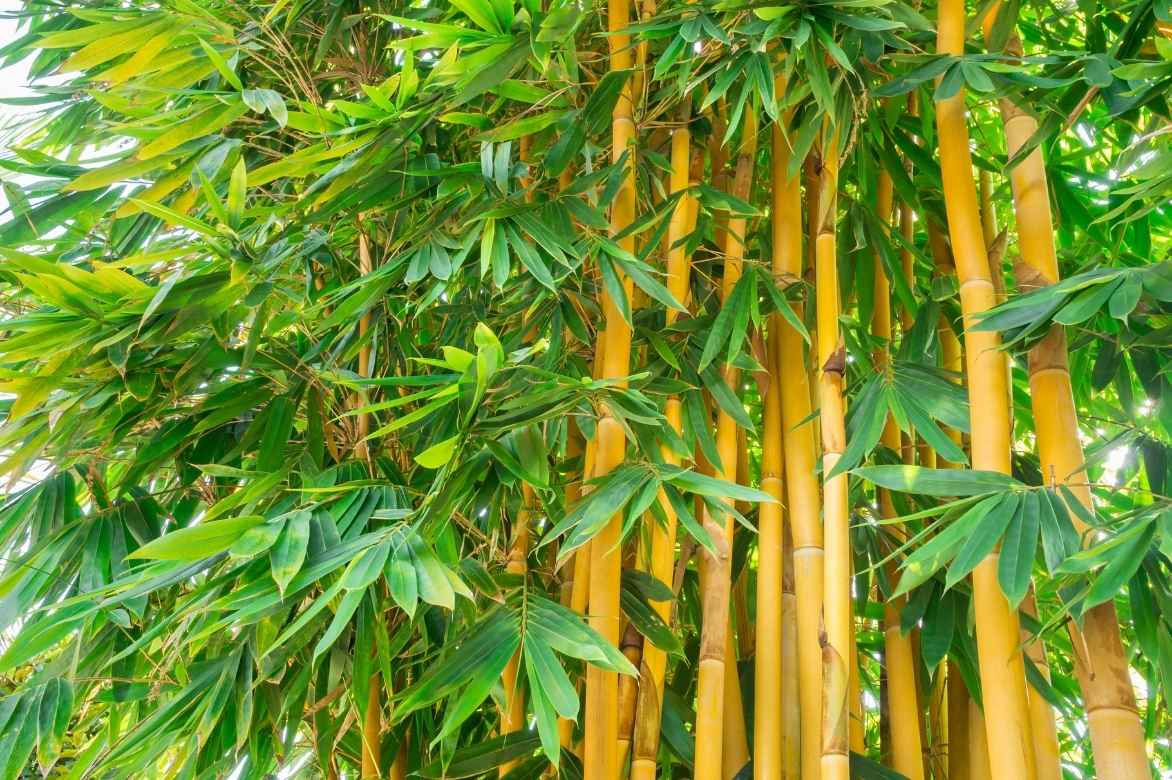
Bambusa vulgaris: lush and exotic!
Botany and description
Botanical data
- Latin name Bambusa sp.
- Family Poaceae
- Common name bamboo
- Flowering extremely rare and insignificant
- Height 6 to 10 m, sometimes over 20 m
- Exposure sun or partial shade
- Soil type rich and light, but moist
- Hardiness -6°C for the hardiest
Bambusas are large bamboos whose stems can reach over 20 m in height in their natural habitat. Bambusas belong to the Poaceae family, formerly known as “grasses,” and more specifically to the Bambusoideae subfamily, which includes all bamboos. The genus Bambusa now comprises around 120 species, primarily distributed across tropical and subtropical Asia. The name “bambusa” is a Latinised form of the Malay word “bambú“.

Bambusa arundinacea botanical plate, circa 1800
Among the many species, notable ones include Bambusa arundinaceae, whose canes can reach 40 m in height; Bambusa vulgaris or Common Bamboo from China, naturalised on almost every continent; and Bambusa multiplex (syn: Bambusa glaucescens), more compact (no taller than 9 m) and better suited to our gardens.
Bambusas form a bushy, dense, and compact clump at the base, spreading upwards. The young shoots, or turions, coloured grey-blue to light green, emerge in summer, mature in autumn, and develop their leafy branches the following spring.
This genus of bamboo produces strong, woody, and hollow canes, sometimes several metres long. In Asia, these canes are used in construction: fences, pipes, scaffolding… The stems, or canes or culms, consist of stacked hollow tubes, partitioned at intervals by nodes, and often arching in their upper section. The culms are upright stems, varying in diameter depending on the species, green in colour, covered with a fine bloom that gives them a slightly bluish appearance. Over time, the canes take on a more beige to brown hue, or even yellowish in the sun.
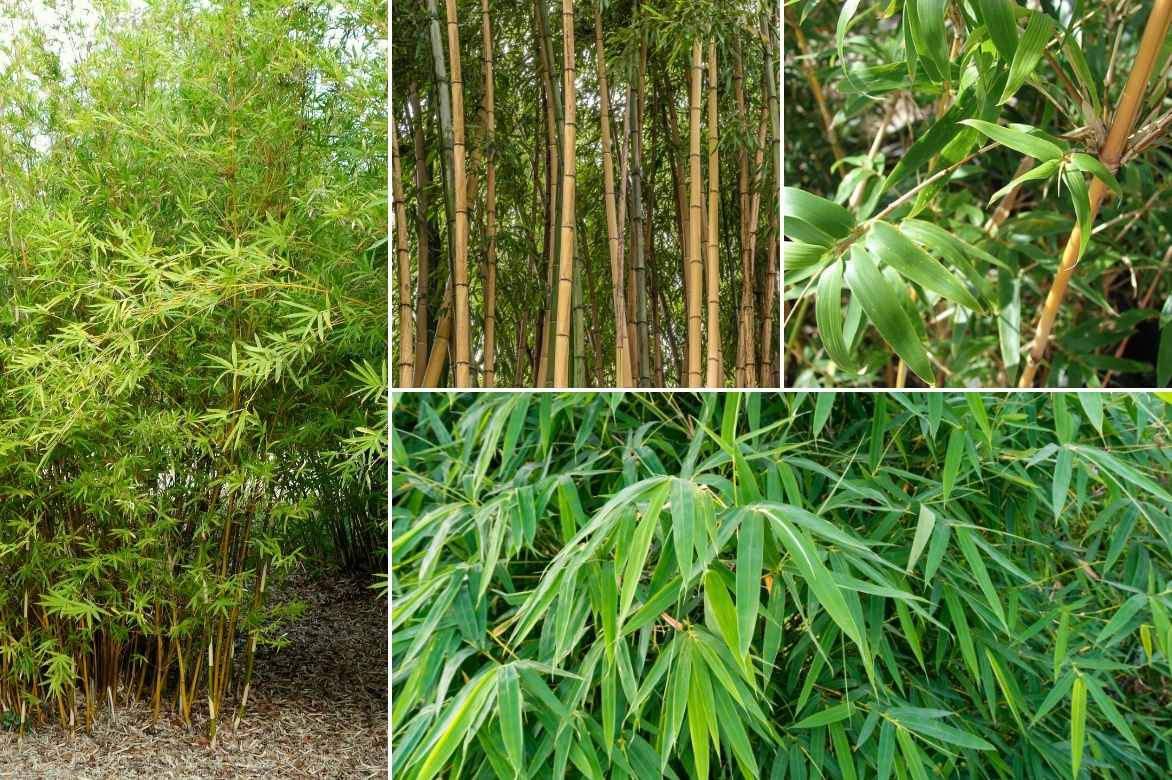
From left to right: Bambusa multiplex ‘Alphonse Karr’ – habit and close-up of culms, Bambusa multiplex (© Forest and Kim Starr), and bottom right Bambusa tulda
In Bambusas, each node has numerous branchings, flexible branchlets bearing dense linear leaves. The foliage on the culms is evergreen and concentrated towards the top of the canes. The leaves are lanceolate and tapered at the tip. Their colour is generally light green on the upper side, with a silvery-grey underside.
As with all bamboos, the flowers, pseudo-spikelets, are insignificant and hidden by the foliage. They appear intermittently in fine, arching panicles. Generally, flowering is very rare. The development of an inflorescence leads to the death of the plant, with the culms withering and dying after flowering.
Bambusas produce short-internoded, non-running rhizomes. They are therefore far less invasive than other types of bamboo: these are known as cespitose bamboos. The clump of Bambusas expands slowly, never thinning at the centre.
This non-running bamboo, very dense in stems and evergreen foliage, is perfect for creating a small hedge or a beautiful green screen in mild climates. It will also make a striking feature as a standalone clump or integrated into a shrub border. Grown in pots, this is the bamboo to choose for decorating a conservatory or large patio.
Our most beautiful varieties
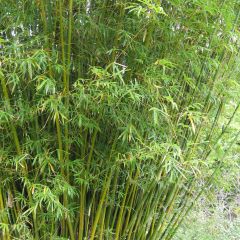
Bambusa glaucescens - Hedge Bamboo
- Height at maturity 6 m
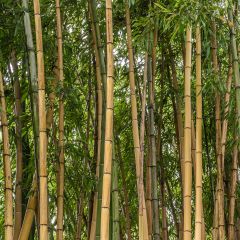
Bambusa glaucescens multiplex Alphonse Karr - Hedge Bamboo
- Height at maturity 4 m
Discover other Bambusa
View all →Available in 2 sizes
Available in 2 sizes
Planting Bambusa
Where to Plant?
Given their limited hardiness (-7°C), bambusas are best grown in pots in conservatories, orangeries, or in the ground in milder regions such as the south-western coastline.
Bambusas prefer partial shade, though they tolerate sun, as long as it is not scorching, as well as denser shade. However, avoid overly dry exposures, as these bamboos dislike arid conditions.
The soil should be rich and humus-bearing, remaining moist, and ideally low in lime (neutral to acidic). If necessary, you can replace your garden soil with a good horticultural compost.
When to Plant?
In theory, container-grown bamboos can be planted year-round, except during frost periods.
Ideally, plant after the peak of summer, from late August to October. This gives the Bambusa enough time to develop a robust root system before winter.
How to Plant?
As a reminder: bambusas are non-running bamboos, known as cespitose, so installing a root barrier at planting is unnecessary.
In the Ground
For varieties with vigorous growth like bambusas, it’s important to account for their mature height and spread. A common method is to take the mature height and multiply it by 3 to determine the adequate space needed to prevent crowding.
Example: for a Bambusa multiplex that will reach about 6 metres in height, an ideal area of 18 m² should be allocated.
- Soak the root ball in a bucket of water for a few minutes to rehydrate it;
- Dig a hole twice as deep and twice as wide as the root ball using a spade;
- Place the root ball in the centre of the hole and backfill with the excavated garden soil, enriched with a good planting compost (special planting compost), well-rotted compost, or manure;
- To keep the soil moist and cool, spread a mulch (straw, dried grass, flax pales, shredded miscanthus…) 6 to 8 cm thick;
- Water thoroughly to ensure good moisture around the roots and to eliminate any air pockets between them and the soil.
Please note: for planting as a hedge or windbreak, space Bambusa multiplex plants one metre apart.
In Pots
Bambusas can be grown in pots, provided watering is carefully monitored. Place the pot in non-scorching sun or partial shade, sheltered from drafts.
- Choose a large container of around 40 litres (at least 50 cm in diameter and depth) with drainage holes at the bottom;
- Create a layer of gravel or clay pebbles at the base of the pot;
- Fill with a rich, well-draining mix of compost, compost, and good garden soil;
- Water generously;
- Apply a mulch to retain moisture.
Maintenance and pruning
Watering
Bamboo requires a lot of water to establish and grow. Water generously at planting time and then very regularly for the first two years of cultivation, especially in summer and when the soil is very dry. Don’t forget to apply mulch to keep the soil cool. Over time, however, bamboos “mulch themselves” thanks to their dry leaves, which decompose very slowly.
Potted specimens require even closer monitoring of watering: do not let the soil dry out too much between waterings. Bambusas can drink up to 5 litres per day during periods of intense heat.
Maintenance
Bamboos thrive in fertile soil. Each spring, an application of compost at the base of the canes will be beneficial. For bamboos grown in pots or containers, a special bamboo fertiliser, rich in nitrogen, can be applied twice a year.
If the leaves of bambusas start to yellow, this may indicate an excess of lime in the soil. In this case, adding a little ericaceous compost to the surface or a mulch of pine needles should solve the problem.
Pruning
Pruning is not essential, but bamboo multiplex tolerates it quite well. You can prune with shears in August-September to shape them or limit their growth. You can also remove dry canes (they can be used as stakes or for creating decorative fences).
Every year, cut back to the base the dry, less vigorous, and most troublesome culms. All these pruned canes will not regrow, but this maintenance pruning will allow the plant to develop entirely new foliage that is denser. The appearance of the bamboo will be greatly improved.
Diseases and pests
Bamboos are resistant to most diseases and parasites. However, they can become vulnerable when weakened by excess water or a lack of nutrients.
When the weather is hot and humid, bamboos grown in pots are sometimes prone to attacks by mealybugs, which feed on the sap and leave farinose or cottony white clusters on the plant. The leaves turn yellow and then fall off, which can lead to the death of the plant in severe infestations. Spraying a mixture of vegetable oil (rapeseed or olive oil), 90° alcohol, and black soap can suffocate them.
Red spider mites can also cause yellowing and drying of the leaves of potted bamboos, which eventually fall off. In this case, there are various eco-friendly solutions presented in the advice sheet Red Spider Mite: Identification and Treatment.
→ Want to learn more about bamboo diseases and parasites? Read our advice sheet Bamboo Diseases and Parasites
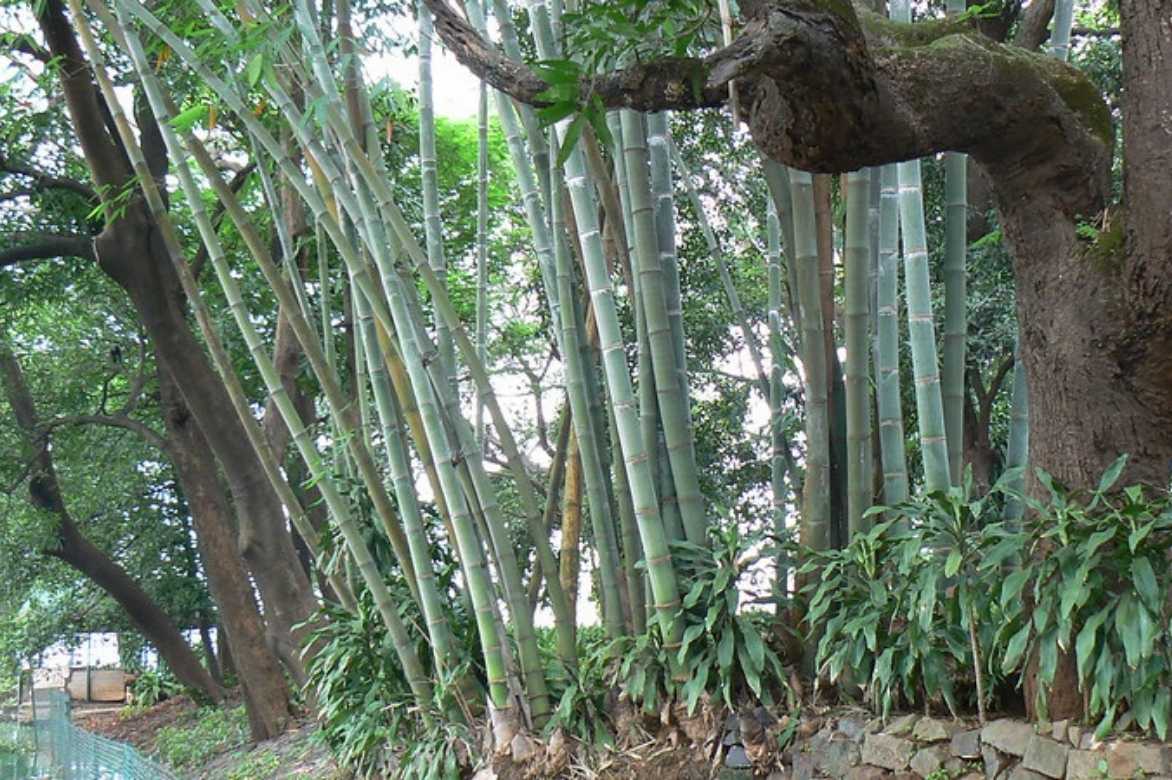
Bambusa multiplex (© Dinesh Vale)
Multiplication
Bamboo propagation is generally carried out in spring, during March-April, by dividing clumps that are at least three years old. The operation is performed when the soil is sufficiently moist, which makes the process easier.
Dividing the clump:
- Using a sharp spade, take a good-sized clump from the edge of the main clump, ensuring it has at least 3 to 5 culms;
- Shorten the culms by one-third of their length, always retaining some foliage, otherwise the clumps will not recover;
- Plant the clump in a hole enriched with good compost;
- Backfill the hole with the excavated soil, firm it down, and mulch;
- Water generously to eliminate air pockets between the soil and the rootstocks, then keep the soil moist but never waterlogged;
- Spray regularly with non-calcareous water on the leaf during dry or windy weather, in the evening or morning. This will prevent the leaves from drying out and ensure good recovery.
Please note: once removed, large bamboos regrow at their juvenile stage. The new culms that emerge will then be smaller in size and diameter. It will take several years before they regain the dimensions of the parent plant.
Association
Bambusas are exotic bamboos, originating from the warm and humid regions of Asia. Ideally, one would recreate an artificial piece of subtropical forest (Asian or otherwise), in a pot in colder regions or in the ground, in a sheltered and semi-shaded spot in milder areas.
A Bambusa multiplex ‘Alphonse Karr’ can be paired with a Schefflera taiwaniana, a bush related to our indoor scheffleras but much hardier (-10°C). For perennials, consider the impressive Strelitzia nicolai or White Bird of Paradise (a little nod to Michel Berger) to add volume and a stunning flowering display. It must be brought into a cold greenhouse during winter.
Large, broad leaves always add an exotic touch, as well as a contrast to the fine leaves of the bamboo: a Colocasia esculenta ‘Black Magic’ and its botanical cousin an Alocasia macrorrhiza or Elephant Ear.
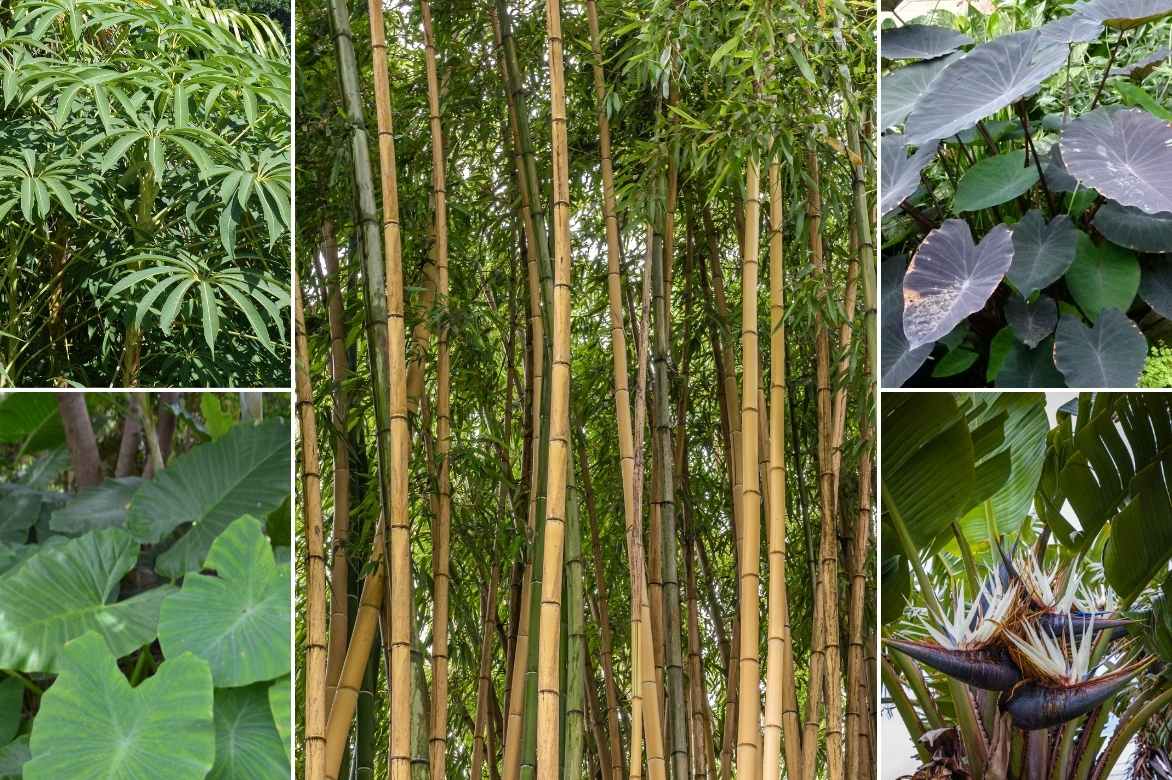
Bambusa multiplex ‘Alphonse Karr’, Schefflera taiwaniana, Colocasia esculenta ‘Black Magic’, Colocasia macrorrhiza, and Strelitzia nicolai.
Also worth reading
→ Discover our bambusas in our online nursery.
There are other non-running bamboos to adopt in your garden. Here’s a small selection: 6 fast-growing non-running bamboos.
Growing bamboos in pots is possible. Here are all our tips: Growing a bamboo in a pot and a short selection of the best bamboos for pots: 6 bamboos to grow in pots.
Worried about planting bamboo in your garden? Michael reassures (or not!) in his article: Should you plant bamboo in your garden?
Find our advice on: How to create a bamboo hedge?
- Subscribe!
- Contents

































Comments